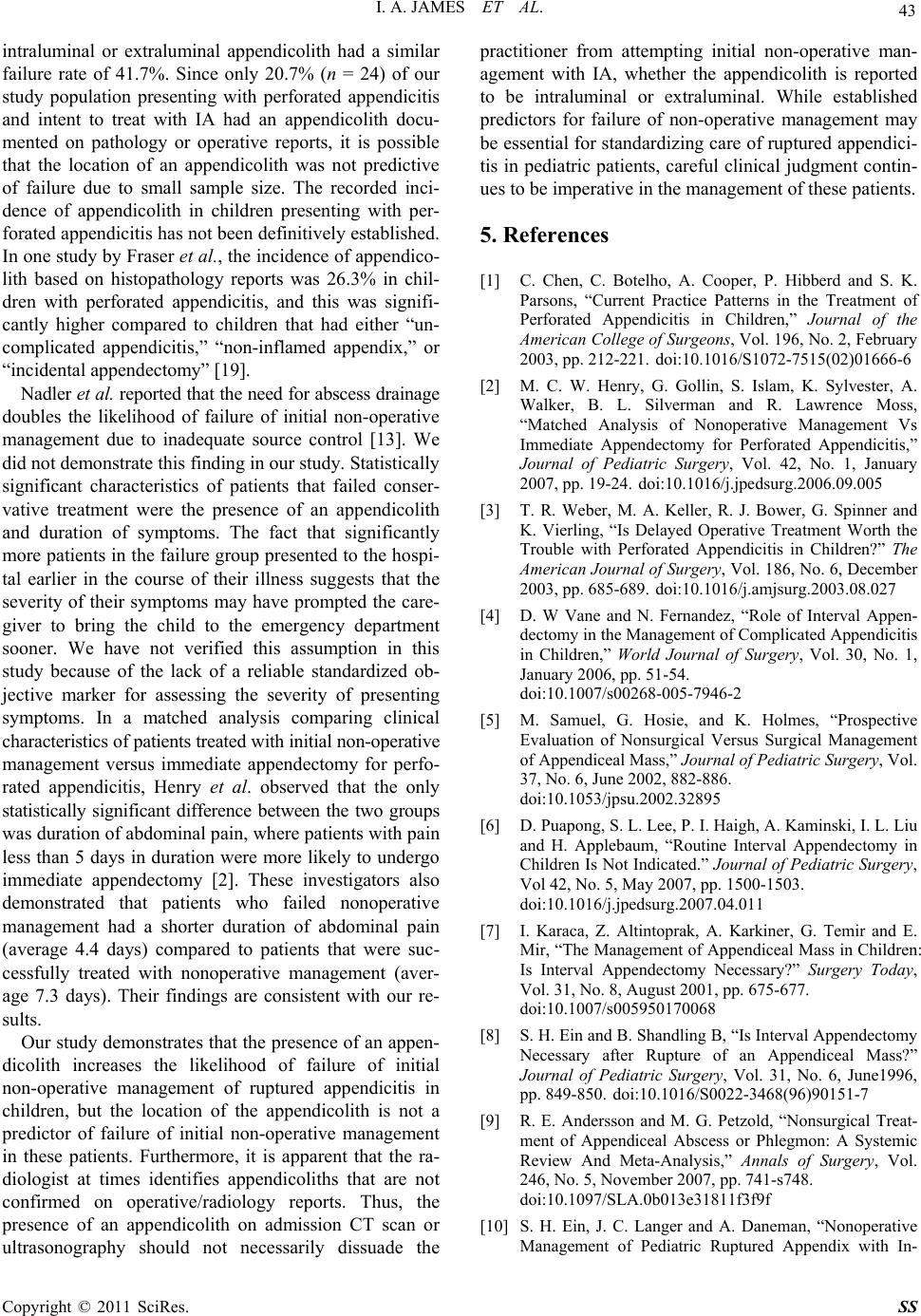
I. A. JAMES ET AL.
43
intraluminal or extraluminal appendicolith had a similar
failure rate of 41.7%. Since only 20.7% (n = 24) of our
study population presenting with perforated appendicitis
and intent to treat with IA had an appendicolith docu-
mented on pathology or operative reports, it is possible
that the location of an appendicolith was not predictive
of failure due to small sample size. The recorded inci-
dence of appendicolith in children presenting with per-
forated appendicitis has not been definitively established.
In one study by Fraser et al., the incidence of appendico-
lith based on histopathology reports was 26.3% in chil-
dren with perforated appendicitis, and this was signifi-
cantly higher compared to children that had either “un-
complicated appendicitis,” “non-inflamed appendix,” or
“incidental appendectomy” [19].
Nadler et al. reported that the need for abscess drainage
doubles the likelihood of failure of initial non-operative
management due to inadequate source control [13]. We
did not demonstrate this finding in our study. Statistically
significant characteristics of patients that failed conser-
vative treatment were the presence of an appendicolith
and duration of symptoms. The fact that significantly
more patients in the failure group presented to the hospi-
tal earlier in the course of their illness suggests that the
severity of their symptoms may have prompted the care-
giver to bring the child to the emergency department
sooner. We have not verified this assumption in this
study because of the lack of a reliable standardized ob-
jective marker for assessing the severity of presenting
symptoms. In a matched analysis comparing clinical
characteristics of patients treated with initial non-operative
management versus immediate appendectomy for perfo-
rated appendicitis, Henry et al. observed that the only
statistically significant difference between the two groups
was duration of abdominal pain, where patients with pain
less than 5 days in duration were more likely to undergo
immediate appendectomy [2]. These investigators also
demonstrated that patients who failed nonoperative
management had a shorter duration of abdominal pain
(average 4.4 days) compared to patients that were suc-
cessfully treated with nonoperative management (aver-
age 7.3 days). Their findings are consistent with our re-
sults.
Our study demonstrates that the presence of an appen-
dicolith increases the likelihood of failure of initial
non-operative management of ruptured appendicitis in
children, but the location of the appendicolith is not a
predictor of failure of initial non-operative management
in these patients. Furthermore, it is apparent that the ra-
diologist at times identifies appendicoliths that are not
confirmed on operative/radiology reports. Thus, the
presence of an appendicolith on admission CT scan or
ultrasonography should not necessarily dissuade the
practitioner from attempting initial non-operative man-
agement with IA, whether the appendicolith is reported
to be intraluminal or extraluminal. While established
predictors for failure of non-operative management may
be essential for standardizing care of ruptured appendici-
tis in pediatric patients, careful clinical judgment contin-
ues to be imperative in the management of these patients.
5. References
[1] C. Chen, C. Botelho, A. Cooper, P. Hibberd and S. K.
Parsons, “Current Practice Patterns in the Treatment of
Perforated Appendicitis in Children,” Journal of the
American College of Surgeons, Vol. 196, No. 2, February
2003, pp. 212-221. doi:10.1016/S1072-7515(02)01666-6
[2] M. C. W. Henry, G. Gollin, S. Islam, K. Sylvester, A.
Walker, B. L. Silverman and R. Lawrence Moss,
“Matched Analysis of Nonoperative Management Vs
Immediate Appendectomy for Perforated Appendicitis,”
Journal of Pediatric Surgery, Vol. 42, No. 1, January
2007, pp. 19-24. doi:10.1016/j.jpedsurg.2006.09.005
[3] T. R. Weber, M. A. Keller, R. J. Bower, G. Spinner and
K. Vierling, “Is Delayed Operative Treatment Worth the
Trouble with Perforated Appendicitis in Children?” The
American Journal of Surgery, Vol. 186, No. 6, December
2003, pp. 685-689. doi:10.1016/j.amjsurg.2003.08.027
[4] D. W Vane and N. Fernandez, “Role of Interval Appen-
dectomy in the Management of Complicated Appendicitis
in Children,” World Journal of Surgery, Vol. 30, No. 1,
January 2006, pp. 51-54.
doi:10.1007/s00268-005-7946-2
[5] M. Samuel, G. Hosie, and K. Holmes, “Prospective
Evaluation of Nonsurgical Versus Surgical Management
of Appendiceal Mass,” Journal of Pediatric Surgery, Vol.
37, No. 6, June 2002, 882-886.
doi:10.1053/jpsu.2002.32895
[6] D. Puapong, S. L. Lee, P. I. Haigh, A. Kaminski, I. L. Liu
and H. Applebaum, “Routine Interval Appendectomy in
Children Is Not Indicated.” Journal of Pediatric Surgery,
Vol 42, No. 5, May 2007, pp. 1500-1503.
doi:10.1016/j.jpedsurg.2007.04.011
[7] I. Karaca, Z. Altintoprak, A. Karkiner, G. Temir and E.
Mir, “The Management of Appendiceal Mass in Children:
Is Interval Appendectomy Necessary?” Surgery Today,
Vol. 31, No. 8, August 2001, pp. 675-677.
doi:10.1007/s005950170068
[8] S. H. Ein and B. Shandling B, “Is Interval Appendectomy
Necessary after Rupture of an Appendiceal Mass?”
Journal of Pediatric Surgery, Vol. 31, No. 6, June1996,
pp. 849-850. doi:10.1016/S0022-3468(96)90151-7
[9] R. E. Andersson and M. G. Petzold, “Nonsurgical Treat-
ment of Appendiceal Abscess or Phlegmon: A Systemic
Review And Meta-Analysis,” Annals of Surgery, Vol.
246, No. 5, November 2007, pp. 741-s748.
doi:10.1097/SLA.0b013e31811f3f9f
[10] S. H. Ein, J. C. Langer and A. Daneman, “Nonoperative
Management of Pediatric Ruptured Appendix with In-
Copyright © 2011 SciRes. SS